This article will cover replacing clutch parts
Replacing the clutch drive cable
During each maintenance, it is necessary to monitor the clutch pedal stroke and the clarity of gear shifting.
Set the clutch release cable to its original position by overcoming the force of the mechanism spring and moving the lower end of the cable forward in the direction of vehicle movement until it stops.
Holding the end in an extended position, measure the size L between the fork and the leash, it should be 27 mm.
If the size does not correspond to the specified value, set it by rotating the leash in the desired direction.
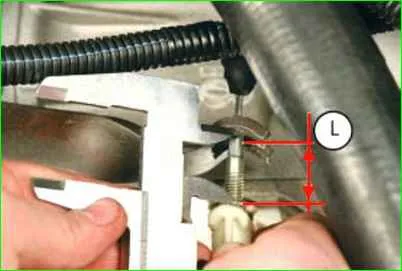
Insert the cable tip into the groove of the clutch release fork and release it.
Under the action of the spring, the tip leash should be installed on the fork without a gap.
Before installing the tip leash on the fork, apply LSC-15 or Litol-24 grease to its surface in contact with the fork.
Press the clutch pedal three times until it stops and re-measure the distance L.
Repeat the adjustment if necessary.
You will need: keys "8", "17", a caliper or ruler.
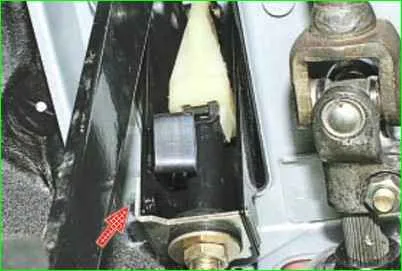
In the passenger compartment, under the instrument panel, use an "8" spanner to loosen the nut securing the cable sheath stop to the pedal bracket and remove the stop from the bracket.
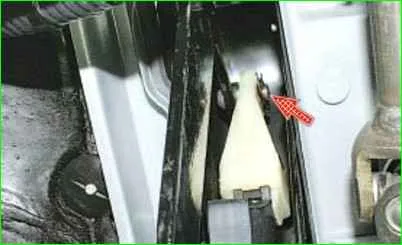
Using a screwdriver, remove the locking bracket and the housing of the wear compensation mechanism of the driven disk linings from the clutch pedal pin.
Remove the plastic bushing from the pedal pin and inspect it.
Replace a heavily worn or damaged bushing by lubricating it with Litol-24 or LSC-15 grease before installation.
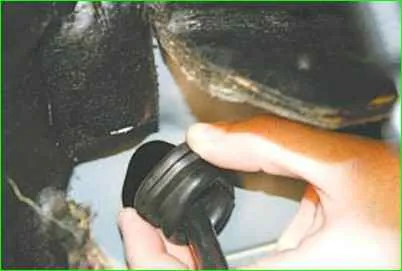
In the engine compartment, remove the seal of the drive cable sheath from the hole in the front shield clutch release
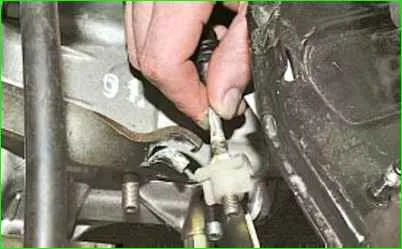
Pull the end of the cable forward in the direction of vehicle travel and remove the end from the groove of the clutch release fork
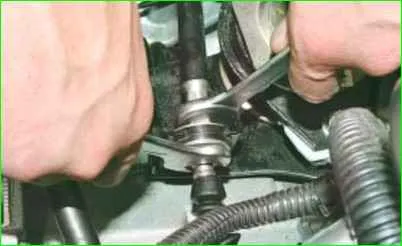
Using a 17 mm wrench, loosen the nut securing the tip to the bracket on the gearbox, using a second wrench to prevent the tip from turning
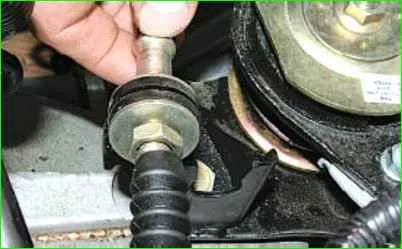
Remove the tip from the bracket and remove the cable from the car, pulling it out of the hole in the front shield
To install a new clutch release cable, first pass it through the hole in the front shield and secure the wear compensation mechanism housing to the clutch pedal pin.
Before installing the wear compensation mechanism on the pedal pin, apply bushing of the finger grease LSC-15 or Litol-24.
Secure the stop of the cable sheath on the pedal bracket.
Install the cable sheath seal in the hole in the front shield.
Install the tip of the cable sheath in the gearbox bracket and tighten the nut of its fastening.
Screw the leash onto the lower tip of the cable, ensuring that the tip protrudes relative to the end of the leash by 0–1 mm.

Install the cable clutch release drive to its original position, for which move the lower end of the cable forward until it stops in the direction of vehicle movement mobile.
Holding the tip in an extended position, measure the size L between the fork and the leash, it should be 27 mm.
If the size does not correspond to the specified value, set it by rotating the leash in the desired direction.
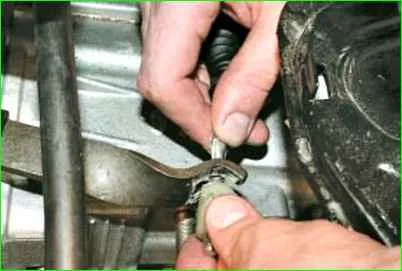
Insert the cable tip into the groove of the clutch release fork and release - under the action of the spring, the tip leash should be installed on the fork without a gap.
Before installing the tip leash on the fork, apply to its surface, contacting the fork, grease LSC-15 or Litol-24.
Press the clutch pedal three times until it stops and re-measure the distance L. Repeat the adjustment if necessary.
Replacing the casing and driven disc of the clutch
We perform the work on an inspection ditch or overpass.
Remove the gearbox.
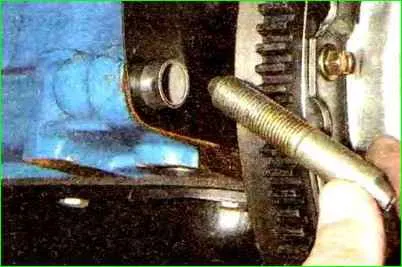
We screw the stud into the threaded hole of the cylinder block M12x1.25 (or the bolt that secures the clutch housing to the cylinder block).
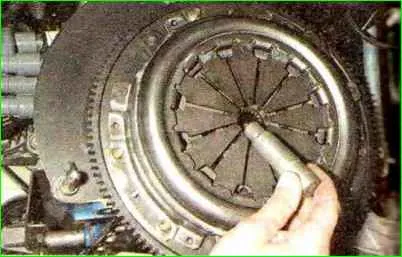
Insert a mandrel or the primary shaft from a classic VAZ gearbox into the holes in the crankshaft and driven disk.
Insert the mandrel so that the basket and driven disk do not fall during unscrewing.
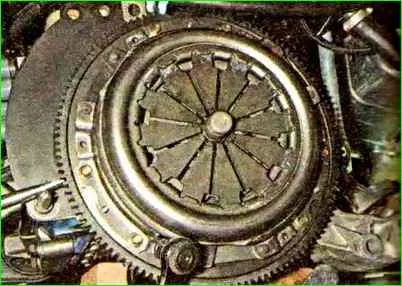
Having installed the mounting blade between the flywheel teeth and resting it on the screwed-in stud or bolt, use an 8 mm head to unscrew the six bolts securing the clutch housing to the flywheel.
Unscrew the bolts evenly, no more than one turn per pass, so as not to deform the clutch housing.
If it is difficult to unscrew the bolts, tap their heads with a hammer with a soft metal tip.
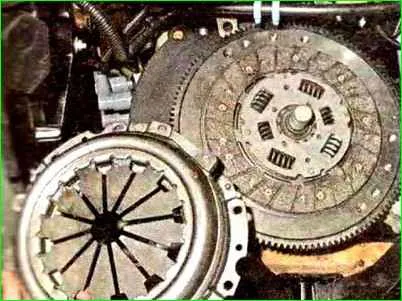
Remove the clutch basket.
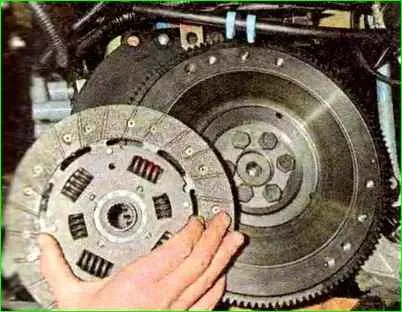
Remove the driven disc
Install the clutch basket and driven disc in the reverse order
When installing, orient the driven disc with the protruding part of the hub towards baskets.
Insert the centering mandrel into the splines of the driven disk and insert the mandrel shank into the hole in the crankshaft flange.
Uniformly tighten the basket mounting bolts diagonally.
The final tightening torque is 19-30 Nm.
After installing the gearbox, adjust the clutch drive cable.
Removing the clutch release mechanism
Removing the gearbox
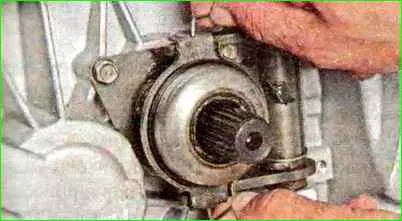
We move the ends of the spring clip away from the tabs of the clutch release bearing housing.
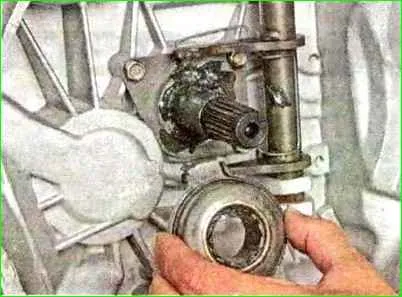
We remove the clutch release bearing assembly with the housing from the guide sleeve.
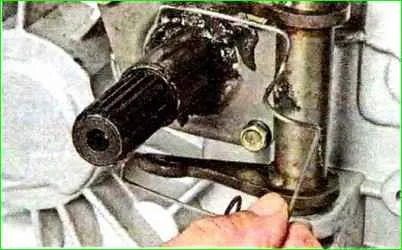
Remove the spring clip of the clutch release bearing.
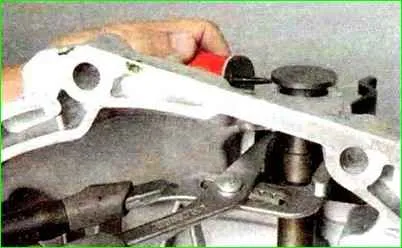
To remove the clutch release fork, Using fine pliers, squeeze the petals of the plastic bushing and pry the bushing off with a slotted screwdriver.
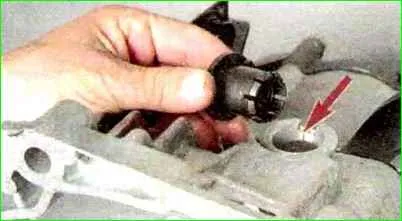
Remove the bushing from the hole in the clutch housing.
During subsequent assembly, the protrusion on the flange of the bushing should fit into the groove (shown by the arrow) of the housing.
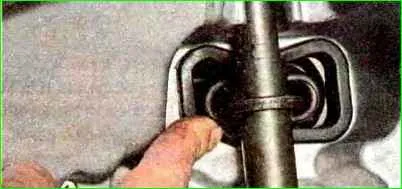
From inside the clutch housing, push out the dirt-protective rubber boot of the clutch release fork lever.
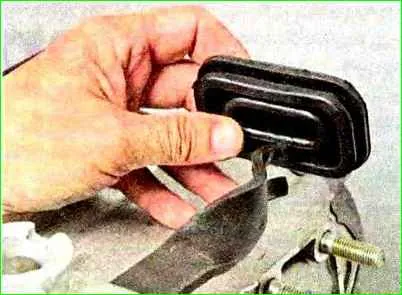
Remove the boot from the lever.
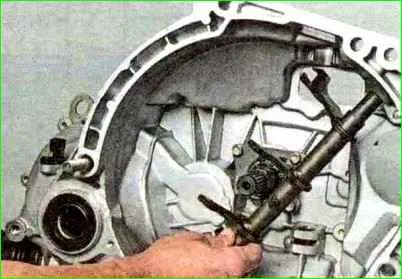
Lift the fork so that its lower part comes out of the hole in the metal bushing pressed into the clutch housing boss, and remove the clutch release fork, bringing the fork lever out through the window in the housing.
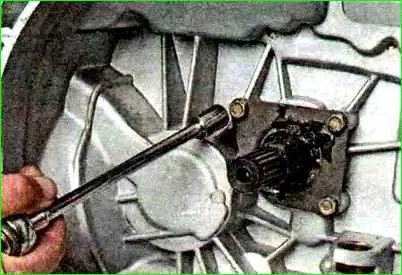
Using a 10 mm socket with an extension, unscrew the three bolts securing the guide sleeve to the clutch housing
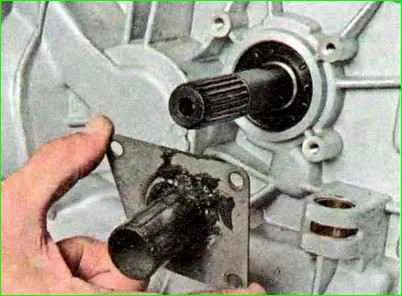
Remove the sleeve
Install the clutch release mechanism parts in the reverse order.
Apply plastic grease to the inner surfaces of the clutch release fork bushings, as well as to the outer surface of the bearing guide sleeve.
Torn rubber boot We replace the clutch release fork lever with a new one.





